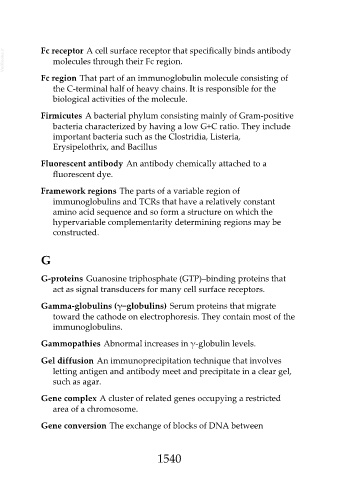Page 1540 - Veterinary Immunology, 10th Edition
P. 1540
VetBooks.ir Fc receptor A cell surface receptor that specifically binds antibody
molecules through their Fc region.
Fc region That part of an immunoglobulin molecule consisting of
the C-terminal half of heavy chains. It is responsible for the
biological activities of the molecule.
Firmicutes A bacterial phylum consisting mainly of Gram-positive
bacteria characterized by having a low G+C ratio. They include
important bacteria such as the Clostridia, Listeria,
Erysipelothrix, and Bacillus
Fluorescent antibody An antibody chemically attached to a
fluorescent dye.
Framework regions The parts of a variable region of
immunoglobulins and TCRs that have a relatively constant
amino acid sequence and so form a structure on which the
hypervariable complementarity determining regions may be
constructed.
G
G-proteins Guanosine triphosphate (GTP)–binding proteins that
act as signal transducers for many cell surface receptors.
Gamma-globulins (γ−globulins) Serum proteins that migrate
toward the cathode on electrophoresis. They contain most of the
immunoglobulins.
Gammopathies Abnormal increases in γ-globulin levels.
Gel diffusion An immunoprecipitation technique that involves
letting antigen and antibody meet and precipitate in a clear gel,
such as agar.
Gene complex A cluster of related genes occupying a restricted
area of a chromosome.
Gene conversion The exchange of blocks of DNA between
1540

